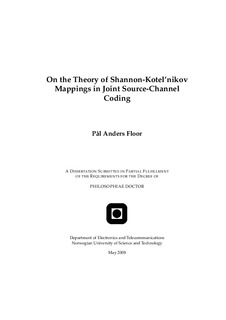| dc.contributor.advisor | Ramstad, Tor | nb_NO |
| dc.contributor.advisor | Lundheim, Lars | nb_NO |
| dc.contributor.author | Floor, Pål Anders | nb_NO |
| dc.date.accessioned | 2014-12-19T13:29:34Z | |
| dc.date.available | 2014-12-19T13:29:34Z | |
| dc.date.created | 2008-05-29 | nb_NO |
| dc.date.issued | 2008 | nb_NO |
| dc.identifier | 124389 | nb_NO |
| dc.identifier.isbn | 978-82-471-1051-5 | nb_NO |
| dc.identifier.uri | http://hdl.handle.net/11250/249749 | |
| dc.description.abstract | In this thesis an approach to joint source-channel coding using direct source to channel mappings is studied. The system studied communicates i.i.d. Gaussian sources on a point-to-point Gaussian memoryless channel with limited feedback (supporting channel state information at most). The mappings, named Shannon-Kotel'nikov (SK) mappings, are memoryless mappings between the source space of dimension M and the channel space of dimension N. Such mappings can be used for error control when MN, called dimension reduction. The SK-mappings operate on amplitude continuous and time discrete signals (meaning that there is no bits involved) through (piecewise) continuous curves or hyper surfaces in general.
The reason for studying SK-mappings is that they are delay free, robust against varying channel conditions, and have quite good performance at low complexity.
First a theory for determining and categorizing the distortion using SK-mappings for communication is introduced and developed. This theory is further used to show that SK-mappings can reach the information theoretical bound optimal performance theoretically attainable (OPTA) when their dimension approach infinity.
One problem is to determine the overall optimal geometry of the SK-mappings. Indications on the overall geometry can be found by studying the codebooks and channel constellations of power constrained channel optimized vector quantizers (PCCOVQ). The PCCOVQ algorithm will find the optimal placing of quantizer representation vectors in the source space and channel symbols in the channel space. A PCCOVQ algorithm giving well performing mappings for the dimension reduction case has been found in the past. In this thesis the PCCOVQ algorithm is modified to give well performing dimension expanding mappings for scalar sources, and 1:2 and 1:3 PCCOVQ examples are given.
Some example SK-mappings are proposed and analyzed. 2:1 and 1:2 PCCOVQ mappings are used as inspiration for making 2:1 and 1:2 SK-mappings based on the Archimedean spiral. Further 3:1, 4:1, 3:2 and 2:3 SK-mappings are found and analyzed. All example SK-mappings are modeled mathematically using the proposed theory on SK-mappings. These mathematical models are further used to find the optimal coefficients for all the proposed SK-mappings as a function of the channel signal-to-noise ratio (CSNR), making adaptations to varying channel conditions simple. | nb_NO |
| dc.language | eng | nb_NO |
| dc.publisher | Fakultet for informasjonsteknologi, matematikk og elektroteknikk | nb_NO |
| dc.relation.ispartofseries | Doctoral Theses at NTNU, 1503-8181; 185 | nb_NO |
| dc.subject | Joint source-channel coding | en_GB |
| dc.subject | Information theory | en_GB |
| dc.subject | coding and compression of analog sources | en_GB |
| dc.subject | SOCIAL SCIENCES: Statistics, computer and systems science: Informatics, computer and systems science: Information processing | en_GB |
| dc.title | On the Theory of Shannon-Kotel'nikov Mappings in Joint Source-Channel Coding | nb_NO |
| dc.type | Doctoral thesis | nb_NO |
| dc.source.pagenumber | 136 | nb_NO |
| dc.contributor.department | Norges teknisk-naturvitenskapelige universitet, Fakultet for informasjonsteknologi, matematikk og elektroteknikk | nb_NO |
| dc.description.degree | PhD i informasjons- og kommunikasjonsteknologi | nb_NO |
| dc.description.degree | PhD in Information and Communications Technology | en_GB |
